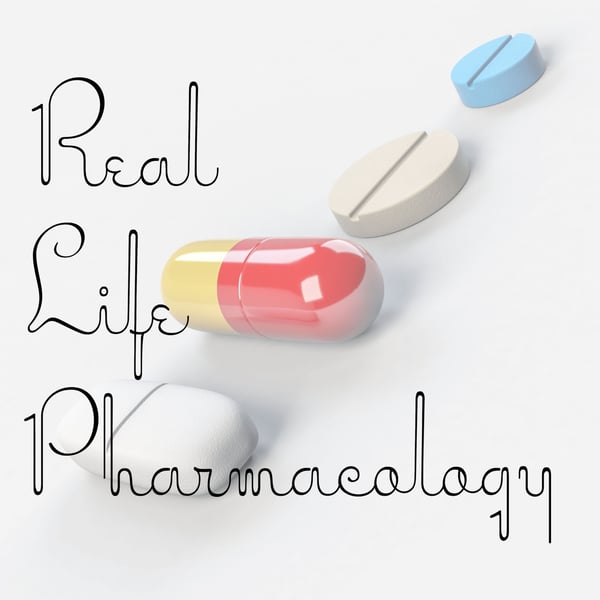Doxylamine Pharmacology
Real Life Pharmacology - Pharmacology Education for Health Care Professionals
Eric Christianson, PharmD; Pharmacology Expert and Clinical Pharmacist
5 • 716 Ratings
🗓️ 8 July 2021
⏱️ 11 minutes
🧾️ Download transcript
Summary
Doxylamine’s adverse reactions are related to its anticholinergic properties, they include dry eyes, dry mouth, increased fall risk, sedation, urinary retention, constipation, and confusion. Contraindications include concurrent use with a monoamine oxidase inhibitor, known hypersensitivities, concomitant alcohol use, and if the patient has the following conditions: elevated intraocular pressure, narrow-angle glaucoma, asthma, peptic ulcer disease, urinary bladder neck obstruction, or gastric outlet obstruction. It is also a Beer’s list drug due to its anticholinergic effects. The normal dose in adults is 25 mg. In cases of overdosage, the most common manifestation is exacerbations of its anticholinergic effects. The major complications of an overdose include arrhythmia, respiratory failure, seizures, hyperthermia, rhabdomyolysis, and coma.
When you know a patient is taking doxylamine, it’s important to be cognizant of their occupation, as well as what other conditions they may have. For example, doxylamine should be used with caution in patients that drive heavy machinery due to its sedating properties. You might be able to tell if a patient’s experiencing an adverse reaction exacerbation if they begin having worsening dementia symptoms or increased urinary retention. Other indications include the use of artificial tears, or saliva, or increased complaints of constipation. To monitor for doxylamine, it’s important to monitor the patient’s tolerability. The onset of doxylamine is relatively quick as well, with a peak concentration within 2-4 hours.
For drug-drug interactions, CYP interactions aren’t as concerning as usual. The main interaction to consider when a patient is taking doxylamine is additive anticholinergic effects. Sedative effects can increase when benzodiazepines, skeletal muscle relaxants, opioids, or antihistamines are concurrently taken. Doxylamine can also counteract the usefulness of dementia or BPH medications due to its anticholinergic properties. There is also a risk of increased anticholinergic burden when taken with skeletal muscle relaxants or tricyclic antidepressants.
Show notes provided by Chong Yol G Kim, PharmD Student.
Transcript
Click on a timestamp to play from that location
| 0:00.0 | Hey all, welcome back to the Real Life Pharmacology podcast. I'm your host, pharmacist, Eric Christensen. Thank you so much for listening. As always, go check out Real Life Pharmacology.com. Go subscribe and get the top 200 drug study guide that I put together. |
| 0:16.6 | 31 page PDF, absolutely free, no cost to you. you simply get it for subscribing and getting updates |
| 0:25.3 | when we've got new podcast episodes and things of that nature so definitely go take advantage of that |
| 0:30.6 | and get that for free and let's get into the drug of the day today and that is doxyxillamine. So doxillamine is a, |
| 0:39.5 | uh, definitely a common over the counter ingredient. And the, the products that I |
| 0:46.8 | associate it most with are like sleep aid, uh, unisome, mucinex, NyQuil, anything that is kind of a PM product or a nighttime product, |
| 0:59.8 | it's going to probably have doxillamine and or, well, not maybe and, but or some of the other |
| 1:07.9 | kind of older first generation antihistamines that can be pretty sedative. |
| 1:13.6 | So, but doxillamine is definitely a common one that you'll find in numerous kind of NyQuil products, |
| 1:20.6 | Musenex, Unisome, as intended to kind of be a sleep aid. |
| 1:25.6 | So it is an older first generation antihistamine, very sedating, |
| 1:31.3 | which obviously makes sense that they would put it in there. In my experience, I don't really see it |
| 1:39.2 | used often at all for allergies or anything else. It's pretty much just for its sedative purposes. |
| 1:47.6 | Usual dose is probably around 25 milligrams. For adults, of course, that type of thing. |
| 1:55.6 | With that said, I have seen the combination used oxylamine with puridoxene, and that has been used in significant cases of nausea and vomiting in pregnancy. |
| 2:09.8 | So that's kind of an interesting little indication besides some of the nighttime or sleep aids and that type of thing. |
| 2:18.9 | So again, understanding that it's a first-generation antihistamine, |
| 2:24.8 | we are going to have lots of anticholinergic adverse effects with this medication. |
| 2:30.8 | And due to that risk, using this medication in geriatric patients, you know, |
| 2:36.8 | those over, you know, 60, 65, 70, it's not a great idea. Okay. And the Beard's criteria |
| 2:43.6 | actually listed for patients 65 years of age and older. We should avoid use if possible. So just a reminder, you know, some |
| 2:54.6 | of those anticholinergic effects. So you get dry eyes, dry mouth, fall risk, sedation, |
... |
Please login to see the full transcript.
Disclaimer: The podcast and artwork embedded on this page are from Eric Christianson, PharmD; Pharmacology Expert and Clinical Pharmacist, and are the property of its owner and not affiliated with or endorsed by Tapesearch.
Generated transcripts are the property of Eric Christianson, PharmD; Pharmacology Expert and Clinical Pharmacist and are distributed freely under the Fair Use doctrine. Transcripts generated by Tapesearch are not guaranteed to be accurate.
Copyright © Tapesearch 2025.

